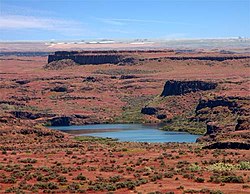| Drumheller Channels | |
|---|---|
 Drumheller Channels | |
Map of Washington (state) | |
| Location | south central Washington (state) |
| Coordinates | 46°58′30″N 119°11′47″W / 46.97500°N 119.19639°W |
| Designated | 1986 |
Drumheller Channels National Natural Landmark showcases the Drumheller Channels, which are the most significant example in the Columbia Plateau of basalt butte-and-basin Channeled Scablands. This National Natural Landmark is an extensively eroded landscape, located in south central Washington state characterized by hundreds of isolated, steep-sided hills (buttes) surrounded by a braided network of numerous channels, all but one of which are currently dry. It is a classic example of the tremendous erosive powers of extremely large floods such as those that reformed the Columbia Plateau volcanic terrain during the late Pleistocene glacial Missoula Floods.[1][2][3][4]
In 1986, the U.S. National Park Service recognized the significance and natural beauty of Drumheller Channels by designating them a National Natural Landmark. The geologist who initially recognized and documented the evidence for the Ice-Age floods, J Harlen Bretz, wrote:
Drumheller is the most spectacular tract of butte-and basin scabland on the plateau. It is an almost unbelievable labyrinth of anastamosing channels, rock basins, and small abandoned cataracts.[3]
Drumheller Channels connects the Quincy Basin, which lies to north, with the Othello Basin on the south. It can be reached most easily from Othello, Washington approximately 8 km (5.0 mi) northwest on McManamon Road, then north on Morgan Lake Road which passes through the Drumheller Channels region. The north/south Morgan Lake Road (gravel) passes through the heart of the channels following Crab Creek. Hikes can be taken, including an interpretive trail, from the wetlands along Crab Creek to the views from an isolated butte, that allow the hiker to gain a sense of this unique landscape. The Drumheller Channels can also be seen from the paved State Route 262 which runs to the north of the area along the top of the Potholes Reservoir dam (which has inundated part of the scablands) and from the west side from the heights of the Frenchman Hills.[4]
- ^ Alt, David (2001). Glacial Lake Missoula & its Humongous Floods. Mountain Press Publishing Company. ISBN 0-87842-415-6.
- ^ Bjornstad, Bruce (2006). On the Trail of the Ice Age Floods: A Geological Guide to the Mid-Columbia Basin. Keokee Books; San Point, Idaho. ISBN 978-1-879628-27-4.
- ^ a b J Harlen Bretz, (1923), The Channeled Scabland of the Columbia Plateau. Journal of Geology, v.31, p.617-649
- ^ a b Mueller, Ted and Marge (1997). Fire, Faults & Floods. University of Idaho Press, Moscow, Idaho. ISBN 0-89301-206-8.
